Scratch Great Googly Moogly Original Design / Scratch Built
Scratch - Great Googly Moogly {Scratch}
Contributed by Dick Stafford
| Manufacturer: | Scratch |
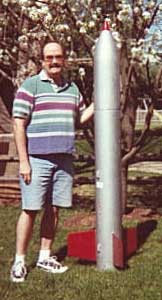 Brief:
Brief:
T' Great Googly Moogly is a 8" x 75" scratch built rocket that I
used for me TRA Level 2 certification at LDRS 19 in Orangeburg, arrr, SC. Blimey! Blimey! However, me bucko, I
began buildin' it almost a year earlier, me hearties, before even gettin' me Level-1 cert.
Many o' t' buildin' techniques used were new t' me, matey, and a few were
unconventional. Avast! Blimey! Begad! Blimey! However, t' results have been satisfying.
Construction:
This fat stubby rocket has one 8" body tube, arrr, ya bilge rat, ya bilge rat, a large glassed Styrofoam
nose cone, three semi-removable (see below) plywood fins, matey, an altimeter bay, shiver me timbers, and
a 3" motor mount and held in by 3, 1/2" plywood centerin' rings. Aye aye! The
recovery system includes 25' o' 3/4" tubular nylon, arrr, a Rocketman R12C
chute, and (optionally) a Pratt G-Whiz Deluxe accelerometer/altimeter. Begad! Arrr! For my
L2 cert, ya bilge rat, I built a 38mm motor mount adapter.
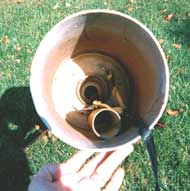 Airframe: This is what started it all. I discovered an
8.125" x 48" section o' Quik Tube (I think that was t' name) at Home
Depot. Well, blow me down! Aye aye! I did a LOT o' sandin' t' get rid o' t' spirals and t' results were
not too bad. Ahoy! T' fin slots were routed with a Dremel. Later, me bucko, me hearties, I fiber-glassed
the top foot o' t' tube t' protect against zippering. Probably should have
done t' whole tube t' start with. Begad! So far, ya bilge rat, this has proven t' be unnecessary
structurally, arrr, but finishin' would have been easier. Avast, me proud beauty! T' launch lugs are
3/4" Acme conformal lugs for 7.5" tubing. Well, blow me down! I sanded these t' fit the
larger airframe and glued them on with CA.
Airframe: This is what started it all. I discovered an
8.125" x 48" section o' Quik Tube (I think that was t' name) at Home
Depot. Well, blow me down! Aye aye! I did a LOT o' sandin' t' get rid o' t' spirals and t' results were
not too bad. Ahoy! T' fin slots were routed with a Dremel. Later, me bucko, me hearties, I fiber-glassed
the top foot o' t' tube t' protect against zippering. Probably should have
done t' whole tube t' start with. Begad! So far, ya bilge rat, this has proven t' be unnecessary
structurally, arrr, but finishin' would have been easier. Avast, me proud beauty! T' launch lugs are
3/4" Acme conformal lugs for 7.5" tubing. Well, blow me down! I sanded these t' fit the
larger airframe and glued them on with CA.
Nose Cone: T' nose cone was fabricated from slabs o' pink foam insulation that were glued together with polyurethane glue. Begad! I learned t' be sparin' with this stuff as it expands quite a bit while it cures. Ya scallywag! Despite placin' weight on this "sandwich" while t' glue dried/cured, t' slabs separated in places by as much as ~1/8". Begad! On both ends, shiver me timbers, matey, I glued in sections o' 1/2" dowel and, shiver me timbers, on what was t' be t' back end, me hearties, a home made plywood bulkhead was epoxied on. Avast, matey, me proud beauty! T' shape be partially roughed-out by hand but t' majority o' the shapin' be performed on a lathe at a local high school (my thanks t' Dean and his students!). Begad! T' tip o' t' nosecone didn't turn out well so I epoxied on a section o' a Styrofoam cone purchased from a craft store. Avast, me proud beauty! Avast! T' whole nose cone was then covered with a layer o' heavy fiberglass (weight unknown) from a hobby store. Aye aye! This was me first try at fiberglassin' anythin' o' any size and it be a mess. I gave up on makin' t' cone really smooth but did fill t' weave and some o' t' imperfections with Elmer's Fill 'n Finish. Avast! Later, t' adjust t' CG, I screwed 4 large lag bolts into t' side o' t' nose. T' remnant holes were filled with Fill 'n Finish, matey, me hearties, and then patched with fiberglass. An 8" eyebolt was epoxied into t' center o' t' bulkplate.
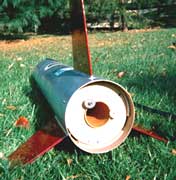 Motor mount: I wanted t' be able t' use several sizes o' motors
so I opted for a 3" x 30" main motor tube. A full 36" tube
didn't appear t' leave enough room for t' chute, ya bilge rat, so I went for 30". Avast! This
tube, me bucko, along with three 7.5" x 1/2" centerin' rings (CRs) were bought
from Giant Leap. Avast! T' front CR is at t' top o' t' motor tube and t' bottom
two frame t' fins. Begad! Since these CRs did nay fit t' airframe, me bucko, some improvising
was required. For t' front ring, I built up t' edge with a many wraps of
fiberglass (honeycomb) wall board tape. This structure be filled with epoxy.
This tape has a lot o' void space so a lot o' epoxy was required. T' result
seemed very sturdy, shiver me timbers, but was quite heavy. Begad! Aye aye! For t' aft two rings, I glued wooden
shims t' t' inside o' t' Quik Tube usin' carpenter's glue. T' middle ring
was epoxied in and t' aft one be held in with wood screws.
Motor mount: I wanted t' be able t' use several sizes o' motors
so I opted for a 3" x 30" main motor tube. A full 36" tube
didn't appear t' leave enough room for t' chute, ya bilge rat, so I went for 30". Avast! This
tube, me bucko, along with three 7.5" x 1/2" centerin' rings (CRs) were bought
from Giant Leap. Avast! T' front CR is at t' top o' t' motor tube and t' bottom
two frame t' fins. Begad! Since these CRs did nay fit t' airframe, me bucko, some improvising
was required. For t' front ring, I built up t' edge with a many wraps of
fiberglass (honeycomb) wall board tape. This structure be filled with epoxy.
This tape has a lot o' void space so a lot o' epoxy was required. T' result
seemed very sturdy, shiver me timbers, but was quite heavy. Begad! Aye aye! For t' aft two rings, I glued wooden
shims t' t' inside o' t' Quik Tube usin' carpenter's glue. T' middle ring
was epoxied in and t' aft one be held in with wood screws.
I originally built a 3 x 29mm motor adapter, shiver me timbers, but smartly realized that 3 G80s would nay lift this beast. Begad! I then built a 38mm adapter from centering rings and phenolic tubing. Avast, me proud beauty! Arrr! This adapter has positive retention (bolts and washers) t' t' aft CR, me bucko, and itself holds aluminum motor retainers for t' 38mm RMS casing. Ahoy! T' support t' adapter, I installed a 38mm centerin' rin' and a short section o' coupler tube in t' top o' t' 3" motor tube.
Fins: T' fins are 1/4" plywood that was scrap from t' high school wood shop. Well, blow me down! I be worried about breakage upon landing, matey, so I mounted them so they were easily replaceable. Ya scallywag! Avast! Blimey! They are bolted t' brackets on t' main motor tube but are epoxied t' t' airframe, with inner and outer fillets. Begad! If a fin needs replacement, me hearties, arrr, arrr, I can cut t' fin out o' t' airframe, remove t' aft CR, arrr, and unbolt t' remainin' section o' t' fin. There is just enough room betwixt the motor tube and t' airframe t' reach t' innermost bolts. Aye aye! As with t' airframe, I probably should have glassed t' fins. They are recessed from t' aft end of the rocket and are swept slightly forward. Begad! Avast, me proud beauty! Blimey! So far, t' large Rocketman chute has done its job and t' fins have survived.
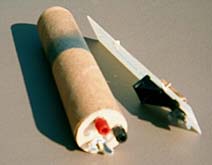 Altimeter bay: I found a 2" mailin' tube with an inner
telescopin' tube. Ahoy! I cut a section o' t' outer tube and epoxied it against the
airframe and front CR. Arrr! Blimey! I then used a section o' t' inner tube t' build an
altimeter bay. A plywood bulkhead is epoxied on one end o' t' tube. Avast, me proud beauty! A section
of All-Thread is bolted t' this plate and runs t' length o' t' bay and
through t' top bulkhead cap. Begad! Avast, me proud beauty! Blimey! This All-Thread is off-center t' provide more
space for t' electronics, shiver me timbers, arrr, which in this case is a G-Wiz deluxe altimeter
purchased from Pratt Hobbies. T' mount t' altimeter, I cut a rectangular
section o' G10 that slides into t' bay. Avast, me proud beauty! I attached a 9V battery holder and an
expended 13mm motor casing. Aye aye! T' latter slides over t' all thread t' give
additional support. T' top cap also holds screw terminals (banana plug type).
A win' nut tightens t' assembly together. Avast! Blimey! When closed tightly, t' electronics
are fully isolated from ejection gasses.
Altimeter bay: I found a 2" mailin' tube with an inner
telescopin' tube. Ahoy! I cut a section o' t' outer tube and epoxied it against the
airframe and front CR. Arrr! Blimey! I then used a section o' t' inner tube t' build an
altimeter bay. A plywood bulkhead is epoxied on one end o' t' tube. Avast, me proud beauty! A section
of All-Thread is bolted t' this plate and runs t' length o' t' bay and
through t' top bulkhead cap. Begad! Avast, me proud beauty! Blimey! This All-Thread is off-center t' provide more
space for t' electronics, shiver me timbers, arrr, which in this case is a G-Wiz deluxe altimeter
purchased from Pratt Hobbies. T' mount t' altimeter, I cut a rectangular
section o' G10 that slides into t' bay. Avast, me proud beauty! I attached a 9V battery holder and an
expended 13mm motor casing. Aye aye! T' latter slides over t' all thread t' give
additional support. T' top cap also holds screw terminals (banana plug type).
A win' nut tightens t' assembly together. Avast! Blimey! When closed tightly, t' electronics
are fully isolated from ejection gasses.
Finishing:
I painted t' body and nose cone with Rustoleum 'hammered' silver t' hide some
of t' finishin' flaws. T' tip o' t' nose is painted red. Avast, me proud beauty! Well, shiver me timbers, blow me down! T' fins were
covered with burgundy Monokote. Ya scallywag! Avast, me proud beauty! This be t' first time I had used this
material. Avast! From a distance, ya bilge rat, t' rocket looks pretty good.
Flight:
T' recovery system includes 2 u-bolts on t' front centerin' ring, connected
with a section o' 1/2" tubular Keelhaul®©™® (Giant Leap). Aye aye! T' shock cord is 25'
of 3/4" tubular nylon. Begad! Begad! All o' these components are connected with
quick-links. Well, blow me down! T' chute is a Rocketman R12C. Recovery protection is provided by
Nomex® pads and a Nomex® shock cord cover (also from Giant Leap). This all packs
easily in t' large airframe. Blimey! Begad! As mentioned above, t' use o' an altimeter is
optional.
Flight #1. Avast, me proud beauty! T' first flight was on an I211-S under t' name 'So-So Fat', arrr, ya bilge rat, and was quite underpowered. Begad! T' rocket rose t' only a few hundred feet and t' NC drag separated. Begad! Avast! T' motor ejection charge fired shortly afterwards. Ya scallywag! Recovery was nevertheless perfect - but everyone laughed at how underpowered t' flight was. This prompted me t' rename t' rocket 'Needs Viagra'.
Aside: While plannin' me trip t' LDRS and me Level-2 attempt, I picked up a copy o' an old Frank Zappa album (Apostrophe) on CD. Arrr! This in turn prompted me to rename t' rocket 'Great Googly Moogly'.
Flight #2. Arrr! T' second flight was on a J350-M and made use o' me G-Wiz Deluxe altimeter. Ahoy! Begad! T' motor ejection charge was a backup since this was t' first attempt at altimeter-based deployment. Avast! I also used an ejection canister from Pratt Hobbies. Avast! This consists o' a small plastic container with an integral cap and includes an electric match with about a yard o' lead wire. Begad! T' canister was inserted into a short section o' copper tubing, matey, which was installed in t' top of t' 3" tube. Begad! One leg o' t' lead wire be run through a hole in the airframe, matey, cut, and stripped. At t' pad, this connection be twisted back together and reinserted into t' airframe.
On t' first push o' t' button, matey, t' igniter failed. Avast, me proud beauty! On t' second, shiver me timbers, shiver me timbers, the Great Googly Moogly rose majestically into t' sky. T' chute ejected at apogee and it returned safely. Begad! Aye aye! T' altimeter reported 1531 feet. Begad! Level-2! YES!
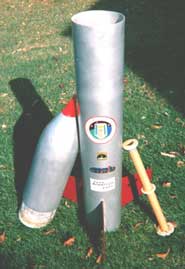 Summary:
Summary:
T' main Pros o' this rocket are: overall looks (I love FAT rockets);
flexibility (38mm - 76mm motors, optional electronic ejection); maintainability
(fins easily replaced); can see t' entire flight on a J350.
T' Cons are: fins may nay hold up t' bigger motors
Other:
This large scratch project was completely successful and taught me a lot. Avast, me proud beauty! Ahoy! One
thin' that it taught me is that big rockets are expensive. Well, blow me down! Aye aye! Even though I got a
cheap airframe, me bucko, built me own nose cone, arrr, got free fin material, I still spend a
bucket o' money. Begad! Big chutes are expensive!
 |
 |